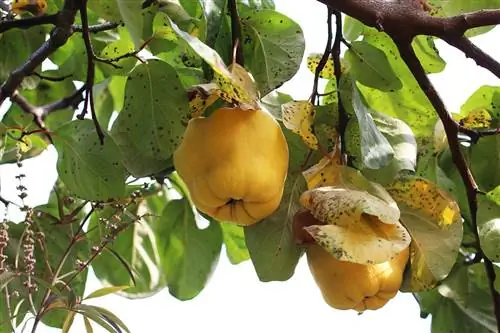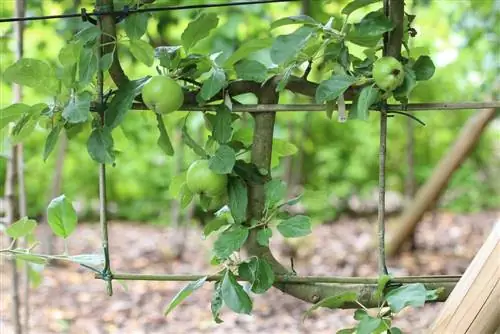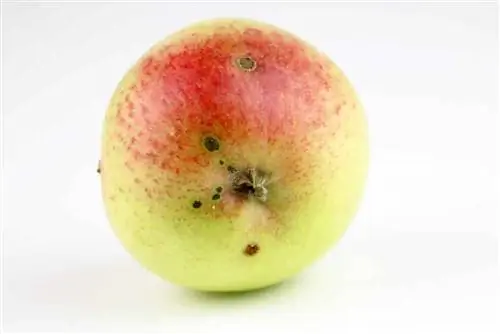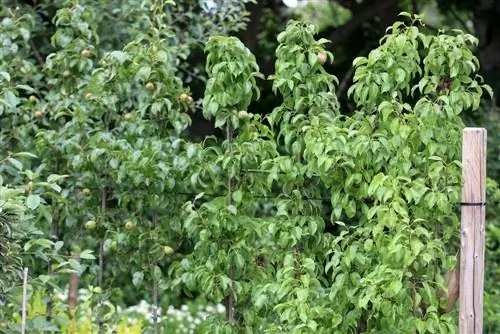- Author admin [email protected].
- Public 2023-12-17 03:39.
- Last modified 2025-01-24 12:45.
Fruit trees are a must in your own garden. But these trees in particular are also plagued by many pests if they are not protected. Natural sprays are always preferable to chemical ones so that consumption is harmless to he alth and still a pleasure. The timing is also important in order to protect the fruit trees well.
The right time
To prevent pests, fruit trees should be sprayed as early as possible in the year. The first right time for this is in late winter, when the first shoots appear. Because various pests like to settle on these fresh, green leaves, twigs and buds. To avoid this, the entire tree is ideally treated in late winter. So the following should be taken into account when choosing the right time:
- always use an overcast day
- no rain or sunshine
- Time window is only very short
- from the first emergence of the buds
- depending on the weather only within two weeks
When the first small buds and leaf shoots appear, the larvae are about to hatch. During this time they are particularly vulnerable and can therefore be easily combated. If sprayed too early, the eggs could still be in a resting phase and the spray used cannot harm them. If sprayed too late, the tree's young leaves could be damaged.
Tip:
It is also helpful to prevent pest infestation by spraying the trunks of the trees with a white coat in late winter. This is a lime coating that is intended, among other things, to protect against the laying of eggs in autumn.
Overwintering pests
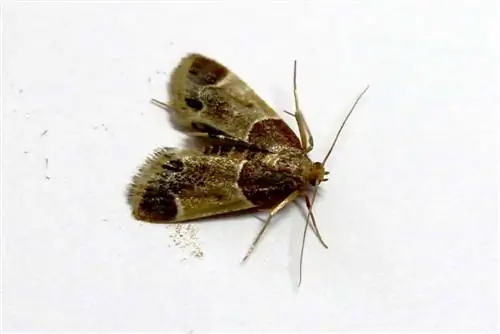
There are many pests that can harm the fruit tree in spring and summer. The fatal thing here is that the pests hibernate on or under the trees and are already present. Either the eggs or the larvae of the individual pests overwinter directly on the trees, in the branches, under the leaves or in the bark, but also in the soil under the tree. Here are the following pests that could attack the fruit trees because they have already survived the winter on the tree:
- Frost moth, scale insect or spider mite
- in the branches and twigs as an egg
- also in cracks or wounds in the bark
- Bloodlice overwinter in the soil
Every insect lays its eggs differently. Fruit spider mites like to lay their eggs on the underside of branches facing the sun, while the offspring of common spider mites survive the winter in the bark.
Sprout spraying
If spraying is carried out in late winter, the fruit trees should be prepared in advance. To do this, the trunks are brushed with a hard brush. In this way, loose pieces of the bark are removed; larvae or eggs could already be deposited underneath. In this way, they can be better reached and destroyed during shoot spraying. You should proceed as follows:
- Use the backpack sprayer
- Spray trees from all sides
- Branches, trunk and branches
- spray thoroughly
- Trees Ideally dripping wet afterwards
Tip:
Spraying should be carried out on a dry, overcast day. When it rains, the spray is washed off too quickly without being fully effective. If the sun is shining, it will dry too quickly and young leaves could also suffer burns.
Floor spraying
Since pest larvae can also overwinter in the soil, this should definitely be treated when spraying in late winter. Not only is the fruit tree itself thoroughly sprayed, but also the ground around it. Nematodes (roundworms) can also be diluted with water and poured onto the soil around the tree. These are the natural enemies of larvae that overwinter in the soil, but do not harm the fruit tree or the crop.
Spraying in case of infestation
If the spraying was missed in late winter or if pests were still visible on the fruit tree in the spring, then a spraying should be carried out immediately if there is an acute infestation. For this purpose, the pests, the nests or the spider-like structures are sprayed directly with the spray agent used. Rinsing with a hose beforehand can also be helpful. Spraying in acute infestations should be repeated as often as necessary within a few days. You should proceed as follows:
- Use a backpack sprayer for large trees
- For small trees, a hand sprayer is sufficient
- spray each visible infestation individually
- additionally spray the entire tree
- repeat the spraying process after two to three days
The spraying can only be stopped when there are no more pests on the fruit tree.
Tip:
To prevent crawling pests from reaching the fruit tree from the ground, glue rings that are attached around the trunk have also proven effective. Crawling insects stick to this and cannot reach the flowers and leaves in the treetop.
Rapeseed oil
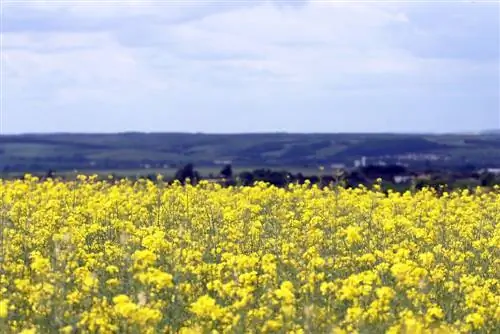
Using rapeseed oil for spraying is natural and, above all, non-toxic. Not only aphids, spider mites, mealybugs and scale insects can be combated with this. Frost moths, cherry fruit flies, cicadas, plum moths and whiteflies also have no chance when sprayed with rapeseed oil. Not only the pests themselves, but also the eggs and larvae can be controlled in this way. However, rapeseed oil does not help against diseases such as scab or monilia. The following fruit trees can be protected from pests with rapeseed oil:
- Berry bushes
- especially currants and gooseberries
- Pome fruit such as apples or pears
- Stone fruits such as plums, cherries or apricots
If the pest infestation is particularly severe, you can also use other means to combat it, which are also based on a biological basis.
Tip:
The spray with rapeseed oil does not have to be made yourself. Specialist retailers already offer ready-made mixtures or concentrates that are diluted with water.
tansy tea and wormwood tea
If the infestation is only minor or if spraying with rapeseed oil did not achieve the desired result because the pest infestation is particularly high, then a spraying and watering with tansy and wormwood tea can be carried out. This combination in particular has proven effective against pest infestation on fruit trees. These natural products from plants are primarily intended to strengthen the fruit trees so that they can defend themselves against pest infestation. As a rule, vulnerable, unstrengthened and sickly trees are unprotected from pest infestation. So that the brew can provide proper protection, it is used as follows:
- water the fruit trees regularly with this
- additional injections regularly
- this is how the plant's own defenses are vitalized
Tip:
Ready-made tea pads are available in well-stocked specialist retailers and on the Internet, which only need to be brewed according to the manufacturer's instructions. This eliminates the need to search for and harvest the plants from which a decoction could then be made.
Horsetail and nettles
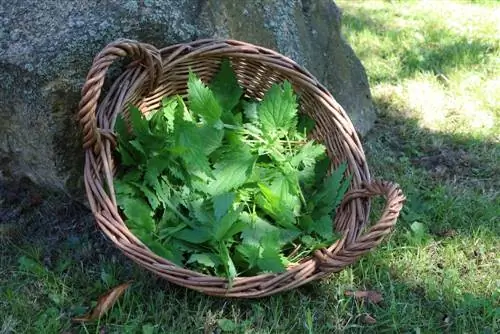
A decoction of nettles or horsetail is also a good home remedy, especially against aphids. However, this is only helpful for light infestations or for small trees. Horsetails and nettles grow everywhere along field or forest paths and can easily be picked for further use. The stock is then made as follows:
- 1 kilo plants
- for 10 liters of water
- pour boiling water over it
- leave it in the water for several days
- Use a covered pot or bucket
- until bubbles form on surface
- Pour out the brew
- mix with water
- use for spraying and watering
Tip:
If you often make a decoction from these plants, you can also create a small bed in a corner of the garden with nettles and horsetail. Since these are weeds, they grow back quickly.
Soda
A solution made from baking soda is good against blood lice. If other pests are to be combated, oils or alcohol must be added. The solutions for spraying light infestations on fruit trees look like this:
- Basic recipe baking soda and water
- half a teaspoon of baking soda for one liter of water
- add an additional teaspoon of cooking oil
- and 1/4 teaspoon of curd soap grate
- then add two teaspoons of pure alcohol
The mixture must be stirred well so that the soap is completely dissolved. The alcohol should therefore only be added at the very end, otherwise it could evaporate. Once the mixture is ready, it is poured undiluted into a spray bottle and used straight away.
Tip:
Instead of pure alcohol, which is available in the pharmacy, organic spirits can also be used.
Soap suds
If there is only a small infestation, you can also use a mixture of soft soap. However, soaps without synthetic additives should always be used. The lye is then sprayed directly onto the pest-infested areas on the fruit trees. The soft soap lye is prepared as follows:
- a tablespoon of soap
- for one liter of water
- add a splash of spirit
The effectiveness is increased even further by adding spirit.
Tip:
It is important if the tree is sprayed well with a hose beforehand to make sure that this is done in the evening when the sun has already set, otherwise the leaves and fruits will burn. If you spray it with water in the evening, it can dry again until the next morning.


